The Failed Gates
by Ken W. Watson
It was the afternoon of Friday, July 16, 1869, when the steam tug Frances, with four barges in tow, arrived at the top of Jones Falls. These were local vessels, the tug and barges had been built on the Rideau and were specifically designed for the canal. Two of the barges, the Algoma and the Mineral were each loaded with 45 cords of firewood destined for Kingston.
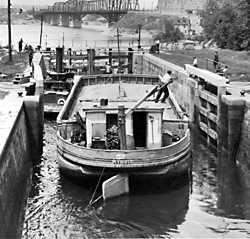 |
| Barge in LockBarges on the Rideau were large, almost filling up the entire lock. Here the barge Minnie (one of the smaller ones at only 96' x 20') is locked through at Ottawa in about 1920. Library and Archives Canada, PA-84504 |
The barges were so large, about 102 feet (31 m) long by 21 feet (6.4 m) wide, that each required its own lockage. Built with a bow, but unpowered, they were a bit unwieldy and required the help of the lock staff as well as the barge crews to manhandle them into the locks.
Lockmaster Peter Sweeney looked on. He was only a couple of years away from retirement, having served as Lockmaster at Jones Falls since it first opened in the spring of 1832. His stomach rumbled, it was almost dinner time. He watched as Michael Kelly, one of the barge hands on the Algoma, grabbed a set of lines and helped guide the barge into the lock.
The Algoma was locked through the upper lock, into the turning basin and on into the top lock in the flight of three lower locks. Michael Trumbles (or Timblin), a local farmer, was standing by this lock with a load of wool he was taking to a mill for carding. He waved to Michael Kelly who was manning the bow of the barge and hopped on board to hitch a ride. The barge was then locked through into the middle lock and the gates between the top and middle locks were closed.
The top lock was now refilled for the next barge, the Mineral, which was waiting in the basin. As the top lock filled, Trumbles noticed an odd creaking noise from the closed set of gates behind him. Trumbles wasn’t bothered by the sound, he’d been around the locks many times, the gates always creaked a bit when the pressure of the water forced them closed. Water was squirting out from near the centre bottom of the two gates, which didn’t quite close. But this had been happening for the last couple of years, he remembered the lock staff complaining that they couldn’t get those gates to stay “true.”
The top lock was now full and its upper gates were opened to allow the Mineral into the lock. As it was being led into the lock, there was a horrible cracking noise and the lower gates of the top lock burst apart. The lock gates, the barge Mineral and tons of water cascaded into the middle lock. The force of this propelled the barge Algoma into the next set of gates which burst apart. The Algoma was swept through these gates and crashed into the lower lock. The Mineral ended up wedged across the lower gate sill of the middle lock.
Poor Michael Trumbles was caught up in the wreckage and drowned in the water of the lower lock. Of the three barge hands aboard the Algoma, two men, White and Burns, made miraculous escapes. White had been with Kelly at the bow of the barge and both were swept off into the water of the lower lock. White managed to not only save himself, he was also able to grab hold of Kelly, and pull him out of the water.
Although he’d been saved from death by drowning, Michael Kelly was badly injured and the men rushed to his aid. He’d been rammed against the gates when the barge was pushed through them into the lower lock, and his right leg was clearly broken. It was also apparent to the men that his injuries were much more serious than just a broken leg – professional help was needed.
The closest hospital was in Kingston and he needed to be transported there as fast as possible. In addition to the Frances, the tug Elswood* was moored below the lock. It was deemed to be the faster of the two vessels,** so Kelly was brought aboard. Captain Michael Conelley had the boiler fired up and, with a full head of steam, the tug headed to Kingston as fast as it could go.
It was still a long trip and it wasn’t until 2 a.m. on Saturday that the tug arrived in Kingston. Aid was summoned and a Dr. Sullivan came out to attend to Michael. He immediately ordered that the unconscious man be transferred to the Hotel Dieu Hospital. Once there, the doctor ascertained that there were fractures in his right leg, thigh, and pelvis, and it appeared to the doctor that Michael was also suffering internal injuries. On July 19th, the Kingston Daily News reported that “Michael Kelly, the man who was so severely injured at the accident at Jones’s Falls, is now lying in a very low and critical state.” Michael died a short time later, the doctor putting the cause of death to be a broken pelvis and a ruptured bladder.
In the meantime, there was consternation about the broken gates at Jones Falls. The Rideau Canal was effectively shut down until new gates could be constructed. By July 23rd, the damaged gates, the wrecked remains of the Algoma and the damaged barge, Mineral, had been removed from the locks. Timber for the new gates was about to arrive, but it was still anticipated that it could take up to four more weeks to build the two sets of gates. The local paper noted that the steamer City of Ottawa remained moored at Kingston. That same paper also had an advertisement stating that the steamer “has been engaged to convey a picnic party to the delightful locality of Jones’s Falls on Wednesday next.” The owners of the steamship had figured out how to make some money from this accident (see the picnic story at the end of this tale).
There was much debate about what exactly happened. How had the gates failed?
During the initial investigation, it was noted that the gates that had failed were of a design change made in 1850. The “river gates” (lower gates) on the bottom lock, which didn’t fail, were of a later 1864 design. The obvious conclusion, one agreed to by Superintending Engineer J.D. Slater, Clerk of the Works Francis Abbott, and Lockmaster Peter Sweeney, was that it was a flaw in the 1850 gate design that had led to the failure. They noted that one of the differences in the two designs was how the gates were joined to the heel post, and this is exactly where the 1850 design gates had broken.
It was the obvious conclusion; it was also the wrong conclusion.
* There is some conflict between the names “Elsworth” and “Elswood” (both were names of local tugs). See the section “The Vessels” for details.
** I’ve made an assumption in the story that Frances was locked through - but it may not have been. The Frances may have been kept in the turning basin to help bring the barges through, or it may have gone back upstream to pick up more barges. This would then be the reason why the Elswood was used to transport Kelly - it was the only available tug.
Why the Gates Failed
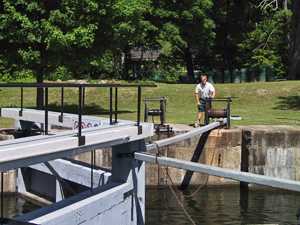 |
| Mitre GatesWater pressure forces the V shape, formed by the two gates when they come together, tightly closed. Photo by: Ken W. Watson, 2006. |
To understand how this accident happened, we first have to understand how Rideau Canal lock gates are built and operate.
A lock gate, although simple in concept, is actually quite a complex design. It has to be able to withstand a great pressure of water, yet be able to freely swing open and closed. It is known as a mitre gate in reference to the shape formed by the gates when closed. They form a V shape (mitre shape) and the pressure of the water actually reinforces the seal. The gates, when closed, come up against a stone ledge at the bottom of the lock called the gate (or mitre) sill. The gates come up against this sill just at the two gates come together, and this forms a watertight seal.
A gate consists of several components. It starts with two vertical posts. The inside post (closest to the lock wall) is known as the heel post or quoin post. It fits into a rounded groove (a recess) in the masonry of the stone pier. This pier is known as a quoin pier or hollow quoin, the latter term referring to the groove (the hollow) in the pier against which the quoin post sits. The quoin post is 16 inches square and rounded on its outside to match the rounded groove in the masonry of the quoin pier.
The outer post is known as the mitre post. It is cut at an angle (mitred) so that the flat surface of this post meets exactly flush with the flat surface of the adjoining gate’s mitre post. The mitre post, at 13.5 inches square, is slightly smaller than the quoin post.
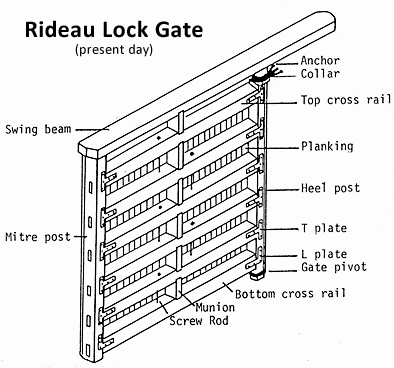 |
| Rideau Lock GateAn illustration of the components of a present day Rideau lock gate (gate bridle not shown). Illustration by Suzanne Plousos from "Working with Tools," 1996. |
These two vertical posts are tied together with heavy timber cross rails. The cross rails are locked into the vertical posts with mortise and tendon joints and braced with metal plates. Vertical braces, called munions, are placed between the cross rails. In the original design, diagonal braces were also used to strengthen the gate. The gates are quite heavy. Today, the large gates at Jones Falls, which have 8 cross rails, weigh about 11 tons (10 tonnes). The gates are currently made using Douglas-fir, so the original gates, made of oak, may have weighed a bit more.
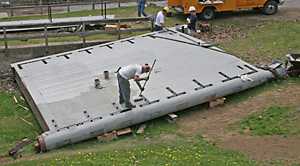 |
| Painting a GateThe planked face of a lock gate being painted (the gate was removed while the quoin pier was being repaired, gates aren't normally removed from the lock except when being replaced). Originally painted brown, the colour was switched to stone grey in the mid 1800s. Photo by: Ken W. Watson, 2007. |
Grooved planks are locked together to form the face of the gate. When originally built, all joints were caulked with oakum (today’s gates are not caulked). Pitch was also used as a sealer. The gates were then painted. They were primed with linseed oil (mixed with a number of other components) and then finishing coats of brown paint were applied. The paint was linseed oil based, coloured with Spanish Brown (red ochre), as typically used by the British military at the time of the building of the Rideau Canal. In the mid-1800s (c. 1860), the colour was switched to stone grey, which is the colour of the gates to this day.
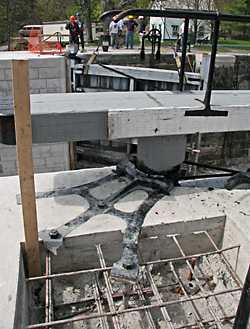 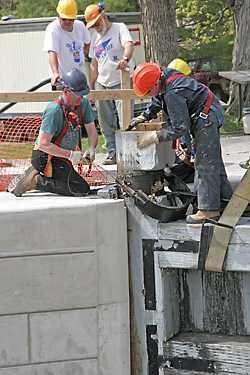 |
| Anchor Plate and CollarThe photo on the left shows the anchor plate (the spider) set into the quoin pier (in this case, a quoin pier reconstructed using cement). The photo on the right shows crews attaching the gate collar to the spider. Photos by: Ken W. Watson, 2007. |
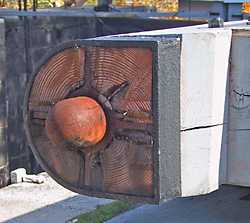 |
| The GudgeonJust in case you were wondering what the bottom ball shape of a gudgeon looks like, here it is, set into the bottom of the quoin post. You can also see it on the left side of the Painting a Gate photo. Photo by: Ken W. Watson, 2001. |
A cast iron anchor plate (the spider – see photo on next page) is set into the top of the quoin pier at the head of the hollow in the pier. This anchor holds the upper collar of the gate. The collar simply wraps around the front of the quoin post. Brass bushings are inset into the quoin post at the collar location so that the wood of the quoin post doesn’t wear as the gate rotates. A gudgeon (an iron teardrop-shaped piece) is placed into the bottom of the quoin post. The bottom ball of the gudgeon sits in an iron cup which is set into the foot box (a piece of masonry that holds the gudgeon cup in the floor of the lock). This is what the quoin post (and hence the entire gate), rotates on. Since the quoin post is allowed a little bit of movement, it forms a watertight seal when the gates are closed and the weight of the water pushes the quoin post tight against the hollow in the quoin pier.
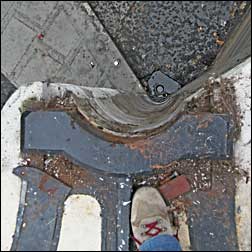 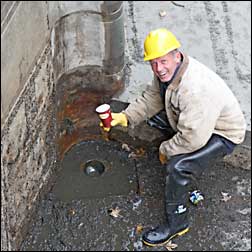 |
| Hollow Quoin and Foot BoxThe photo on the left is looking straight down the quoin pier to the foot box. The quoin post of the gate fits snugly in this hollow. The photo on the right shows the gudgeon cup in the foot box (nicely bailed out by Dave Drader). Photos by: Ken W. Watson, 2009. |
In the initial design, there was worry about the gates sagging under their own weight. In addition to the cross bracing put in place to prevent this, a wheel (a truck) was placed near the middle bottom of the gate to help support it. This wheel ran along a metal track in the bottom of the lock.
The gates have undergone several design changes over the years. A change made in 1850 was initially blamed for the gate failure at Jones Falls. In that change, the tendons in the cross rails, which originally went completely through the quoin post, now went only halfway through. The upshot of that change was that bolt holes in the reinforcing plates for the timber cross rails, as well as draw bar holes in the tendons, were now all in line. So, for each cross rail, there were 5 holes in line, as opposed to 3 closely spaced together (for the reinforcing plate) in the original design. On the high lift gates at Jones Falls, this resulted in 40 holes, all in line, in the quoin posts. When the gates broke, the gates sheared on this line of holes, and the conclusion was naturally made that this was the cause of the failure.
Closer examination revealed that the wood was sound where the gates had sheared, and that the shearing was a result of the gate failure, not the cause. The gates in question were only 11 years old and should have been good for another 4 to 9 years (the early gates, made of oak, lasted from 15 to 20 years, the longest lasting gate made it to 27 years). A second theory was advanced that a piece of wood had been caught in the bottom of the gate, preventing it from closing, and that water pressure twisted the gate, causing it to fail. This had actually happened a few years previously (1860) at Kingston Mills. This theory was much closer to the truth.
The gates that failed had been constructed by a Mr. Edward Dufton in the spring of 1858. When the Rideau Canal was built in 1827-1832, the gates were built on-site at each lockstation, to the exacting specifications of the Royal Engineers, and under the supervision of Mr. Fitzgibbon, the Master Carpenter. So, all the original gates fully met the Royal Engineers’ demanding standards. But after the canal was opened, new gates were built under contract, and quality control suffered. The gates built at Jones Falls in 1858 were poorly done. Over time they started to sag. This caused the top of the gates to seal before the bottom. Water pushed through the partially open bottom, eroding the top edge of the sill. The bottom of the mitre post was also wearing down due to the sag. This eventually reduced the bearing surface of the mitre post from 5 inches down to about 3 inches. This meant that more water pressure was being applied against a smaller portion of the top of the gate sill.
On July 16, 1869, as the water was raised in the top lock, putting pressure on the gates and on the top edge of the gate sill, the sill broke (sheared) in the centre. This allowed water pressure to push the mitre post up and over the sill, twisting the gates and ripping them off (ripping the quoin posts in two). The second set of gates was simply broken by the water pressure and weight of the barge Algoma slamming against them. Where each gate broke is in fact a testament to the strength of the anchor collar and the foot box – neither of which broke. They held the quoin post in place, and each gate ripped apart at the next point of weakness, the line of bolt holes. But, it is to be noted that it was the sill that had broken causing the gates to fail, the ripping at the bolt holes of the gates a result, not a cause, of the failure.
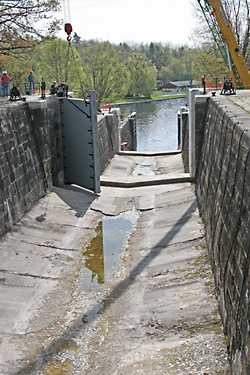 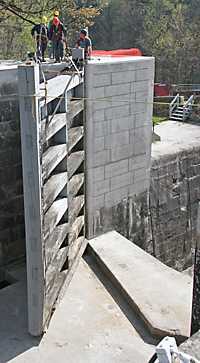 |
| Gate/Mitre SillThis is the actual gate sill at Jones Falls that broke in 1869, causing the gates to fail. Originally done in masonry (stone) it has since been re-done in cement. Photos by: Ken W. Watson, 2007. |
odfellow, a carpenter who cut up the gates stated “I have examined the gates which gave way. I cut them up to get off the iron. They are the soundest I ever cut up. They were perfectly sound, and I cannot account for their giving away.”
Significant changes didn’t have to be made as a result of the accident, since the problem of poor construction had already been addressed in the mid-1860s. Superintending Engineer J.D. Slater re-designed the lock gates in 1864 and by 1866 had fully implemented a policy that all gates would be built by Rideau Canal staff, ensuring quality control on the construction of the gates. More vigilant lock inspections were implemented, to prevent any similar problem happening at another lock.
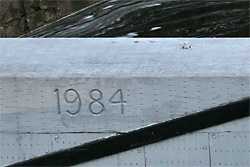 |
| Date on a GateEach gate on the Rideau Canal shows the year in which it was built. Photo by: Ken W. Watson, 2006. |
The gates are still made by Rideau Canal staff, at the gate shop in Smiths Falls. The design has been changed a few times. The centre bearing wheel was done away with in the early-mid 20th century. Today, in addition to all the regular bracing, a diagonal tensioning rod (the gate bridle) is used from the anchor collar to the mitre post to make sure the gate stays square and doesn’t sag (a somewhat controversial modification since it adds more strain on the quoin pier). The gates are tested on a regular basis using resistance drilling to detect internal rot long before that damage becomes visible. In addition, all the gates are dated, so that it is obvious to everyone how long the gates have been in place at a particular lock.
The locks at Jones Falls were re-opened (for partial traffic) on August 17, 1869, just over a month from the day the gates failed. The inquest jury found “that Michael Kelly died of injuries received on Friday, the 16th day of July, by the breaking of the lock gates at Jones’s Falls, caused by the negligence of the government officials.”

Sources:
Note: most of the technical information about the lock gates and the 1869 failure was taken from Robert Passfield's highly detailed "Lock Design and Construction"
Bush, Edward Forbes, Commercial Navigation on the Rideau Canal, 1832-1961, History and Archaeology Series 54, Parks Canada, 1981
Daily News (Kingston) articles. From transcriptions by Rick Neilson on www.hhpl.on.ca/GreatLakes/Scripts/News/SearchGLNews.asp (July 13, 17, 19, 23, 26, 27, 29 and August 16, 1869)
McLeod, Ken, per comm., 2008 [Rideau vessel information]
Osborne, Brian, Byways #6 - Drama at the Locks, Rideau Reflections (Friends of the Rideau newsletter), Winter/Spring 2001.
Passfield, Robert W., Canal Lock Design and Construction: The Rideau Canal Experience, 1826-1982, Microfiche Report Series 57, Parks Canada, Ottawa, 1983.
Plousos, Suzanne, Working with Tools, Work, Identity and Perception Communicated through the Material Culture of Work in the Context of the Rideau Canal Construction, 1826-1832, MA Thesis, College of William and Mary in Virginia, 1996.
The Vessels:
Barge Algoma: built at Dog Lake by Absalom Campbell in 1866 [McLeod, 2008].
Barge Mineral: built at Bedford Mills by William Gorrell in 1868 [McLeod, 2008]. Bush notes that John Chaffey built a barge Mineral (102 feet long) at Bedford Mills in 1871 [Bush p. 205]. Was this a replacement or repair for the original Mineral, damaged in the accident at Jones Falls in 1869?
Steam Tug Frances: built at Bedford Mills by John Chaffey in 1864. It was 55.2 feet long by 11.4 feet wide [Bush p.184].
Steam Tug Elswood: built at Bedford Mills by John Chaffey in 1865. It was 49.1 feet long by 11.8 feet wide. It may have been powered by a high pressure 40 hp steam engine [Bush p.183]. There is some conflict in the records regarding the tugs Elsworth and Elswood. The former is mentioned in several of the newspaper clippings as being the tug that brought Michael Kelly to Kingston. However, it was the Chaffey brothers’ tug Elswood and its companion tug Frances, that appear to have been bringing barges up and down the Rideau at that time. So although there apparently was a tug named Elsworth it is assumed that it was in fact the Elswood that was used. The Daily News on July 13, 1869, (just a few days before the accident) reported: “tug Francis [sic] with four barges for the Rideau Canal; and tug Ellswood [sic] and four barges for the same destination.”
Steamer City of Ottawa: built at Montreal by Peter G. Water in 1864. It was built for Moss K. Dickinson. It was a paddle-wheel steamship, 107.5 feet long and 16.4 feet wide. It was powered by a 35 hp low pressure steam engine and could make 12 knots. At the time of the accident at Jones Falls it was owned by the Montreal & Ottawa Forwarding Company [Bush p.175].
There is some conflict in the records regarding the tugs "Elsworth" and "Elswood." The former is mentioned in several of the newspaper clippings as being the tug that brought Michael Kelly to Kingston. However it was the Chaffey Brother's tug "Elswood" and its companion tug "Frances", that appear to have been bringing barges up and down the Rideau at that time. So although there apparently was a tug named "Elsworth" it is assumed that it was in fact the "Elswood" that was used.
The Daily News on July 13, 1869 reported : "tug Francis [sic] with four barges for the Rideau Canal; and tug Ellswood [sic] and four barges for the same destination."
An 1869 Picnic Excursion to Jones Falls

During the time the lock was shut down, the paddle wheel steamer, City of Ottawa, had been tied up at a wharf in Kingston. Turning loss into opportunity, the ship owners arranged for a cruise to Jones Falls on July 28, 1869. The City of Ottawa was a precursor to the "Palace Steamers" that would ply the Rideau in the late 19th and early 20th centuries. Almost 108 feet long, it had 10 state rooms, a ladies' cabin and a 90 foot long saloon. It was described as having the most recent and improved appointments. Passengers travelled in style and comfort.
The ship left Kingston with Captain John Burrowes at the helm and the passengers apparently had a lovely day, enjoying the cruise from Kingston to Jones Falls and back. The Daily News of July 29, 1869 describes the voyage:
The Excursion To Jones's Falls - The excursion by the steamer City of Ottawa to Jones's Falls on the Rideau Canal on Wednesday proved a remarkably successful and pleasant affair. The boat had quite as many passengers as it could well accommodate, and the party was made up of a very desirable company. Colonel Paton and the officers of the battalion had among the patrons of this excursion (got up in behalf of the band fund) the Mayor, the County Judge, the Sheriff, the Brigade Major, the Police Magistrate, the City Clerk, and a large number of gentlemen and ladies attracted by the interest of the novelty of an excursion on the Rideau Canal, and the desire to see the locality of the recent disaster.
The boat left at eight o'clock to the music of the band, and soon made its way to Kingston Mills, where the tedium of locking was killed by a good many getting on shore and spending the forty-five minutes' detention in examining the neighbourhood. While the boat was in the lock under the great tubular bridge which spans the romantic gorge at this place, a Grand Trunk freight train rattled across overhead, and furnished a new sensation to the excursionists.
Speeding along through a varied course of artificial canal and natural lakes, as well as what used to be the dismal feature of this route, the "drowned lands," the aspect of which is now completely changed owing to the entire decay of the standing timber, the boat passes successively the lock at Lower Brewer's Mills, and the two locks at Brewer's Mills, the latter the seat of an important water power and extensive saw mills, now rented from Mr. Robert Anglin to an American firm largely engaged in the manufacture of sawed lumber for exportation to the United States.
Next some narrow contracted cuts blasted from the solid rocks have to be passed, by the rugged side of which the boat almost grazes, soon to emerge into wide expanses of lake with rocky or timbered banks, not so bold as at Kingston Mills, but quite picturesque, and having considerable resemblance to the much admired scenery of the lower Scottish Highlands. To the great majority of the party the scenery was entirely new. Few Kingston people indeed know the Rideau Canal, which, besides its great public works, has many unpretending attractions to recommend it to the tourist. Some sudden turns in the channel have to be repeatedly followed, each revealing a change of view very much like what is seen in the Lake of the Thousand Islands near Gananoque, where the channel of outlet is not always immediately visible.
At Jones's Falls the empty locks, with the ruined gates hanging on their broken hinges, as seen from the steamer, tell the story of the late break in the canal at this place, while as the steamer approaches the landing shore nears a wrecked and sunken barge, the fated vessel which was being passed through at the time of the disaster. Her crushed sides and battered stern tell of the violent usage to which she was subjected by the rush of water through the locks, and the crushing of the gates upon her.
The party having landed hurriedly visit the great works and select the ground for picnicking under the shady trees on the hill side in full view of the bay at the foot of the locks. The examination of the stupendous masonry of the locks and of the great dam, an immense work costing alone 40,000 pounds sterling, proved of much interest. Next the falls had to be visited - a very pretty foaming waterfall - and very soon the time allotted for the stay was consumed.
The return voyage was begun between four and five in the afternoon, and the boat got in about ten o'clock, after an exceedingly pleasant day had been spent. This excursion is said to be the second of the kind from Kingston in the course of twenty-five years, but from the expressions of delight and satisfaction uttered by the participants in the excursion of Wednesday it will not be difficult to get up a third within a very minute fraction of that length of time.
|